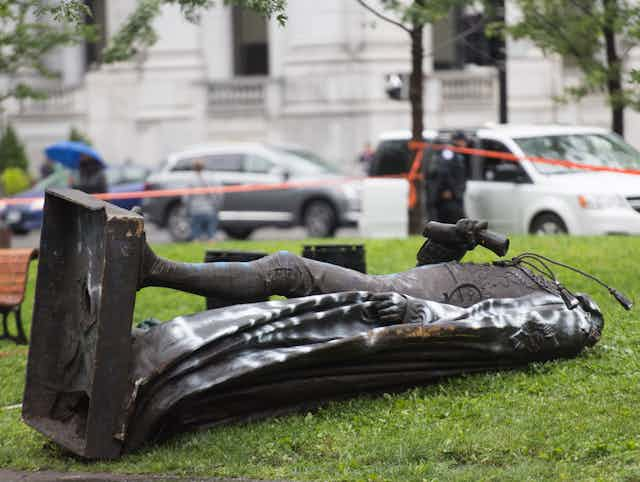Last August, a statue of Sir John A. Macdonald, Canada’s first prime minister, was toppled in downtown Montréal by a group of activists following a protest march. “People were tired of waiting for it to be removed,” said one protestor. “In Canada, racism can be polite and covert and this statue was a symbol for people who still have Macdonald’s way of thinking. The statue was an open wound.”
Aside from the COVID-19 pandemic, 2020 was also profoundly marked by street protests — some of which led to vandalism — including demonstrations against controversial monuments that represent divided past heritage and painful memories.
The phenomenon has gone global. Around the world, various activist groups have taken matters in their own hands, targeting particular public statues representing U.S. Confederate figures, Canadian political leaders and British colonialists.
“Few monuments in the U.S. or around the world for that matter seem safe from scrutiny at the moment,” notes journalist Phillip Morris.
Today’s timing
The recent public interest in memorials emerges at the very moment when long-established Western traditions are falling apart and people are looking for new representations of the past.
For German historian Jörn Rüsen, history offers a moral and cultural compass to orient people’s life by combining a vision of past, present and expected future. Surveys such as Canadians and their pasts reveal that history continues to play a significant role in providing citizens with a sense of direction for their fast-changing world.
Yet for some, statues of political and military figures no longer offer meaningful references and cultural signposts.
“I think that the continued vandalism of these kinds of statues is an important representation of continued engagement in that history,” Omeasoo Wāhpāsiw said in an interview with CBC in October.
Another reason for this intensified sense of historical consciousness is the empowerment of previously marginalized groups. The rights revolution of the last half-century, as Michael Ignatieff contends, is the political and social story of the struggle of all human groups to gain inclusion. For the first time in history, we are “trying to make democracy work on conditions of total inclusion.”
This rights revolution has come at a cost: it makes society harder to control, more contentious. For historian Jack Granatstein, it has literally “killed Canadian history” as the recognition of these rights has made us more individualistic, fragmented and mindful of our differences.
For others, however, killing Canadian history has made it possible to “take seriously the existence of racisms and asks questions about their roles in shaping institutions and experiences, including those of dominant groups.”
Historical awareness
Dealing with controversial monuments is not a mere matter of taking them down. It is a serious, complex question due to the impassionate public opinions and the multiple contexts in which these debates take place.
Unfortunately, the current debates are based on narrow political agendas that evade democratic commitment, community-building and historical complexity. Canada’s multicultural pasts are deeply-rooted, intertwined and multifaceted, and need to be analyzed and recognized as such.
As a scholar of history education, I believe that every citizen, from children to adults (including political leaders), would gain from a progression towards more sophisticated forms of historical consciousness that encourage inquiry, critical deliberation, historical empathy and different perspectives.
People apply — often unconsciously — different patterns of meaning-making when dealing with monuments. Some are concerned with how to preserve monuments as a way to uphold certain traditions.
Others see such controversial monuments as anachronistic representations of another era that poorly fit our own modern times. Removing them is seen as necessary to justify present-day moral values.
These visions of the past — and the present — seem incompatible as they offer radically different responses to questions of history and identity. Trying to sort right from wrong is unlikely to work, as each side holds different truths.
So what are the alternatives?
History lessons
There is no simple answer as so much is dependent upon people and context. Viable solutions to how to deal with controversial monuments are most likely to emerge from what political theorist Benjamin Barber called “democratic education.” This is a deliberative learning process where people participate in democratic communities, think critically and deliberately in a pluralistic world, and exercise their empathy so as to understand their fellow citizens.
A precondition for this deliberation is the realization of one’s own sense of historical consciousness. As long as people are unable to understand the standpoints and intentions of others, they are unlikely to engage in an informed dialogue.
Self-awareness and structural change in people’s thinking are not intuitive; they are to be found in education.
Through democratic education, it is possible to envision shared commemorative projects. We can subsequently develop policy guidelines for both the preservation and design of public monuments that are better suited for contemporary life.
A recently suggested solution by the Commission permanente de l’art public in Montréal recommends a “multilayered practice” that could “add new layers of meaning, new projects and not to remove them.” Keeping monuments does not necessarily mean accepting the original representation.
Monuments are public sites of memory. They play important history, commemorative and artistic functions. They belong to us, the citizens. Thus, it is important to use democratic education to develop an approach that is open to inclusive understandings of the past.

